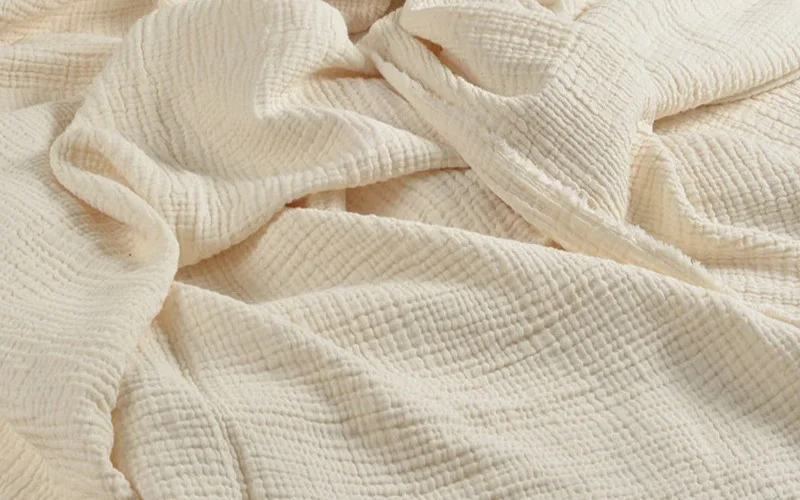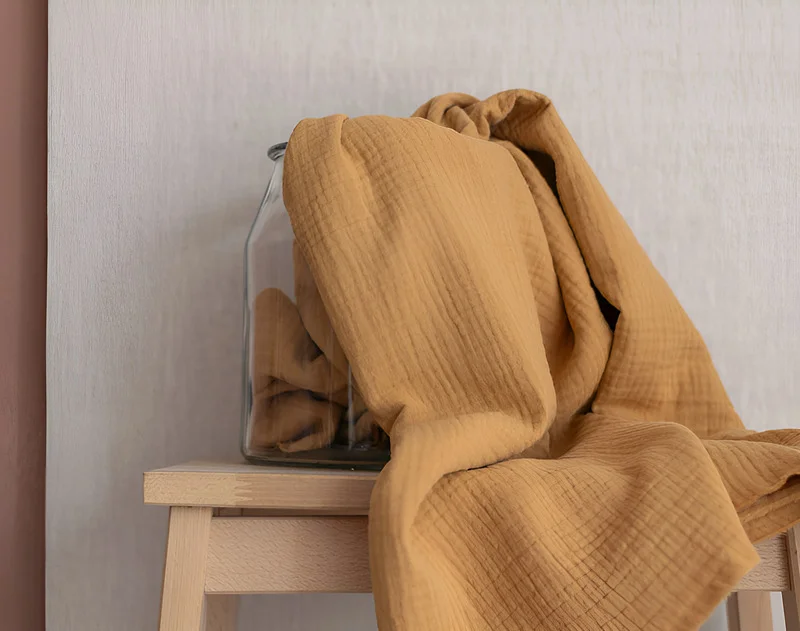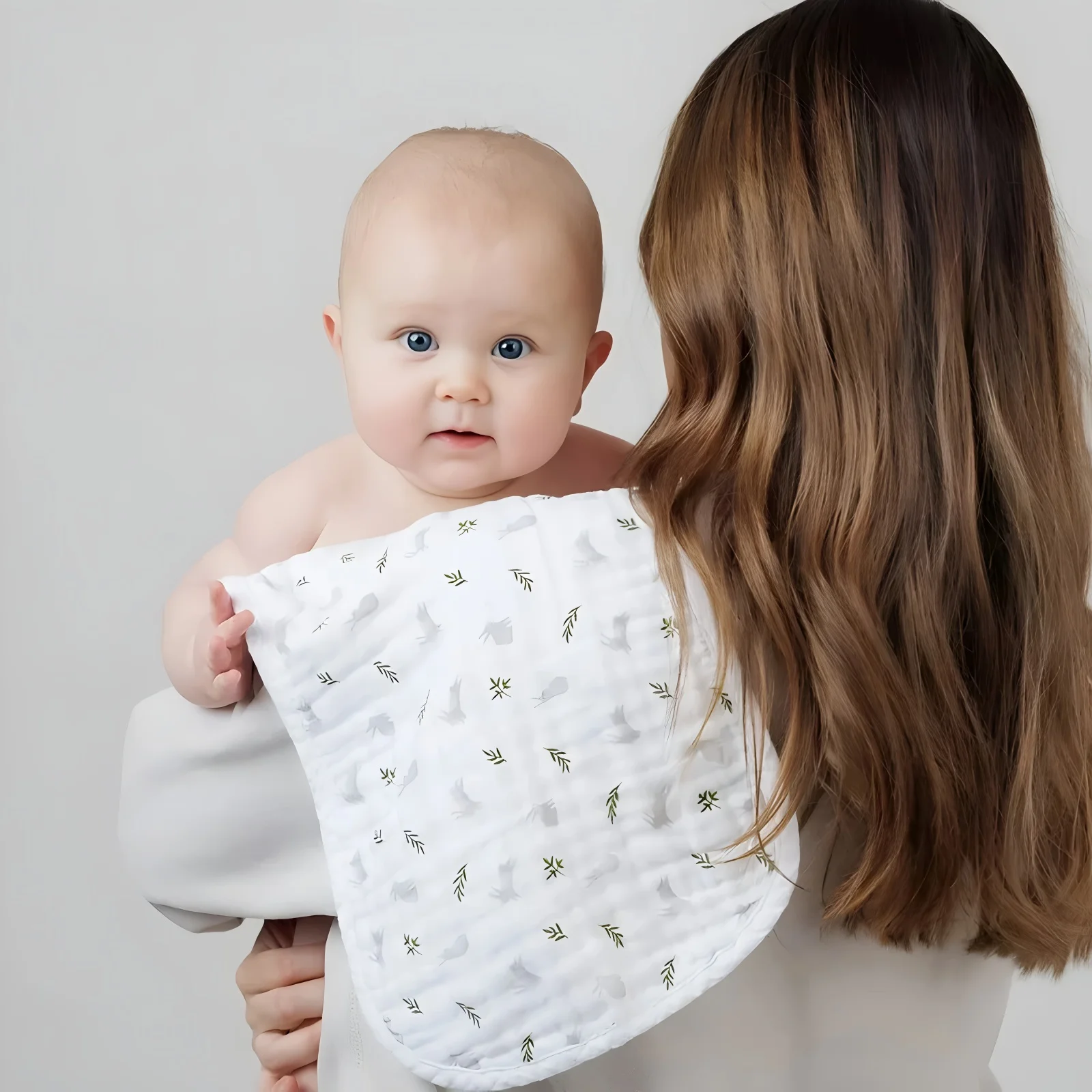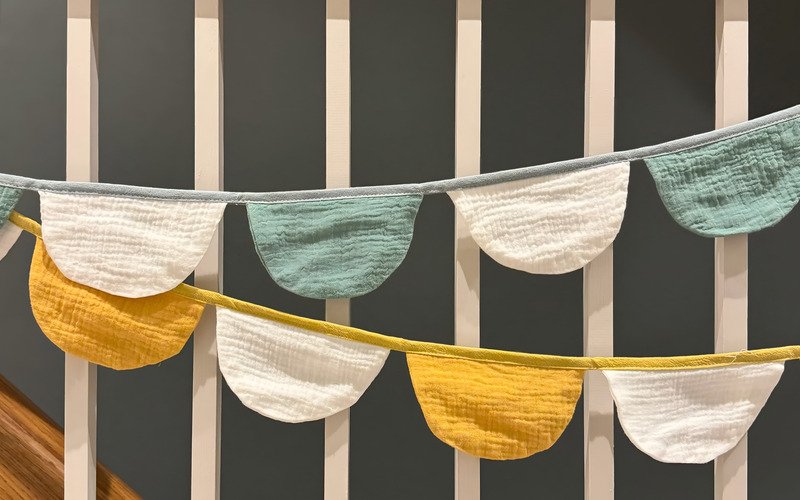What Is Muslin: Soft Fabric Uses, Benefits And Simple Care
Muslin is a simple, lightweight, and soft cotton fabric that is incredibly versatile. You can find it in everything from clothing and baby items to household goods and crafts. Its natural feel makes it a great choice for many applications. Understanding muslin helps you choose the right materials for your projects or products.
1. What is Muslin Fabric?
1.1. What is muslin?
Muslin is a simple, soft, and lightweight cotton fabric. It’s made using a “plain weave”—the most basic method where threads are woven in a simple over-and-under pattern. This technique is what gives muslin its characteristically light and breathable feel.

1.2. Why should you know about muslin?
You might see or use muslin more often than you think! It’s in baby items, clothes, and even in your kitchen. Understanding muslin material helps you know what things are made of. This can help you make better choices for your needs or your creative projects.
2. What Makes Muslin Special?
2.1. The material: mostly cotton
Most muslin is made from cotton. This is why muslin usually feels soft and lets air flow through it easily. Being a natural fabric, it has a gentle touch.
2.2. How it’s made: plain weave
Muslin is made with a plain weave fabric structure. This is the simplest way threads are woven together. Imagine threads going over one thread, then under the next, then over, then under. It’s like a simple grid or when you weave paper strips in crafts. This weave makes the fabric light and gives it a flat, not fancy, texture.
2.3. How it feels: soft and natural
Muslin usually feels soft and gentle, not scratchy. A nice thing is that it often gets even softer the more you wash it! It can look a little wrinkly, which is normal. This is part of its natural, comfy look. Unlike some fabrics that can feel stiff, muslin is naturally soft and flexible.
2.4. How heavy is it? usually light
Muslin is generally a lightweight fabric. It is not heavy or thick. Think of a light t-shirt or a thin summer scarf, not a heavy winter coat. This lightness makes light cotton muslin comfortable to wear or use for many things.

2.5. Can air pass through? yes, it’s breathable!
Muslin is a breathable cotton fabric. This means air can move through the fabric easily. This is a great benefit. It helps keep you cool in warm weather. For babies, this breathable quality is especially important.
It helps prevent them from getting too hot. This is a big reason it’s so popular for things like summer clothes and baby swaddles.

2.6. What it looks like: often natural colors
You’ll often see muslin in its natural muslin color. This is a soft, creamy white – like cotton before it’s dyed. It can be made in other colors too. But this simple, natural look is very common. Muslin usually isn’t shiny; it looks flat (matte).
3. Are There Different Kinds of Muslin?
3.1. Different weights and finishes
Yes, not all muslin is exactly the same. Some muslin is very, very thin and light, almost see-through. You might hear this called ‘gauze’. Other muslin is a bit thicker and the threads are closer together, good for things like simple shirts or sheets.
But even the thicker kind is still generally a light fabric compared to something like denim. You don’t need to know all the special names for types of muslin fabric. Just know there’s a small range in thickness.
3.2. How this changes what it’s used for
These small differences in muslin affect the best uses for muslin fabric.
- Very thin muslin (like cheesecloth) is great for things like straining food in the kitchen.
- Slightly thicker muslin is better for making clothes, crafts, or simple bags.
4. What Do People Use Muslin For?
Muslin is used for many different things.
4.1. Making clothes
Muslin is used for many types of clothing.
- Practice clothes for dressmakers (called “toiles” or “muslins”). Dressmakers and designers often use muslin to make a test version of clothing. This is called a “toile” or “a muslin.” Muslin is usually not expensive. So, it’s okay if they make mistakes or want to change the design. They can draw on it and cut it easily to get the perfect shape. This is a key use of muslin for sewing patterns in toile making.
- Light clothes for warm weather (dresses, shirts). Because muslin is light and lets air through (it’s breathable!), it’s wonderful for summer muslin garments. Think of loose, comfy dresses, shirts, skirts, and light pants.
- Baby clothes (because it’s soft). Muslin is very soft and gentle. This is perfect for a baby’s delicate skin. So, it’s often used for simple muslin baby clothes like gowns, tops, and lightweight rompers. These are popular handmade goods.
4.2. For babies
Muslin is a favorite for many baby items.
- Swaddle blankets to wrap babies. Large squares of soft muslin are perfect for wrapping babies snugly. This is called swaddling. A muslin swaddle can help babies feel secure and sleep better. Muslin is good because it’s soft and makes a great breathable baby blanket.
- Burp cloths. Muslin is good at soaking up little messes (it’s absorbent). It’s also soft, so it makes great muslin burp cloths for babies. Plus, they are easy to wash.
- Light blankets. A muslin blanket is great for a light cover that won’t make the baby too hot. This is especially good in warmer weather or indoors.
4.3. Around the house
Muslin has many uses in home décor and for practical tasks.
- Light curtains. For home decor, muslin is often used to create lovely, light curtains. They let some sunlight filter through softly. They give a bit of privacy and add a soft, airy look to a room.
- Bed sheets. Some people love muslin sheets, especially in warm places. They are breathable and feel soft, helping to keep cool at night.
- Cloths for cleaning or polishing. Because it’s soft and doesn’t usually leave lint, muslin cleaning cloths can be used for gentle dusting. They are good for polishing delicate surfaces without scratching them.
- Backgrounds for photos. Photographers sometimes use large pieces of plain muslin as a simple photography backdrop fabric. It gives a clean, neutral look for portraits or product photos.
4.4. In the kitchen
Muslin is handy in the kitchen, especially very thin types.
- Straining liquids (like juice or when making cheese). Very thin muslin, often called cheesecloth muslin, is excellent. You can use this straining cloth to pour liquids through to remove small bits. This is useful for straining juice or making cheese. This is a popular use of muslin for cooking.
- Holding spices for cooking. You can make little muslin spice bags to put herbs and spices in. Then, put this bag into your soup or stew while it cooks. This adds flavor without leaving bits of herbs.
4.5. Crafts and DIY fun
Muslin is great for many craft projects and handmade goods.
- Making dolls. Muslin is easy to sew and is often used as fabric for doll making. Crafters use it for the body of simple, soft dolls.
- Testing sewing ideas. Crafters can use muslin for crafts to test small sewing patterns for toys or decorations. This is good before using more expensive fabric.
- Embroidery or fabric painting. The plain surface of some muslin makes it a good embroidery fabric or base for fabric painting on DIY muslin projects.

4.6. Simple bags for small things
Muslin fabric is wonderful for making simple little muslin bags. These often have a drawstring to pull them closed. People use these drawstring bags or muslin pouches to hold small gifts, jewelry, or dried herbs. They are also a natural way to package small handmade products. These bags look natural and feel soft.
They can be a lovely, eco-friendly fabric packaging choice. They give a thoughtful, handmade touch, which is great for sustainable packaging solutions. Many people who make and sell small items, like soaps or candles, love using simple muslin pouches.
5. Why is Muslin a Good Choice?
Muslin is a popular fabric for so many reasons. Here are some of its main benefits of muslin fabric:
- Very soft: It usually feels very soft and gentle on your skin. This is especially good for babies or anyone with sensitive skin.
- Lets air through: Air can pass through it easily. This helps keep you cool and comfortable, especially in warm weather.
- Light to carry and wear: It’s not a heavy or bulky lightweight fabric. Clothes made from it are light, and items like blankets are easy to handle.
- Sucks up water well: Muslin can soak up liquids. This makes it good for things like kitchen towels, cleaning cloths, or baby burp cloths.
- Often cheaper: Compared to many other fabrics, muslin is often less expensive. This makes it great for practice projects or simple items.
- Easy to sew with: The fabric is usually stable and not too slippery. This makes it easier to cut and sew, especially for beginners.
- Looks natural and simple: It has a plain, honest, and natural look that many people love.
- Eco-friendly (when 100% cotton): Since most muslin is made from cotton, it can break down naturally over time. This is better for the environment than synthetic fabrics.
6. How to take care of muslin things
Taking care of your muslin items is usually easy. Here are a few tips on how to care for muslin garments and labels.
- Washing: It’s generally best to wash muslin fabric gently. You can use your washing machine on a cool or warm water setting with a mild soap. Avoid very hot water.
- Drying: You can hang muslin items to air dry. If you use a dryer, choose a low heat setting. High heat can sometimes make muslin shrink more.
- Ironing: Muslin can be ironed if you want it smooth. Use a medium heat setting. Many people like the natural, wrinkly look and don’t iron it.
Important Tip: It might shrink! This is important! Muslin, especially 100% cotton, can shrink the first time you wash and dry it. Does muslin shrink? Yes. If you plan to sew with new muslin, wash and dry it before you start. This is a crucial first step in proper garment care for muslin items.
7. Muslin and Your Brand
7.1. A natural look for products
Using muslin can help your brand project a natural, handmade, or eco-friendly image. This could be for the products or for packaging, like simple muslin for product packaging. Muslin gives a feeling of simplicity and care.
It suggests a natural brand identity. It perfectly matches their brand’s story of being natural and thoughtful. Using natural fabrics for branding materials can strengthen your custom branding for eco-conscious products.
7.2. What about labels for muslin items?
If you make things from muslin, you’ll want to add a label. This could be a brand label or a care label. Soft labels are often best for muslin. The label should match the natural feel:
- For muslin baby clothes or garments: Soft woven labels are an excellent choice. For instance, damask woven labels offer a soft yet durable finish that won’t irritate the skin, making them perfect for muslin baby clothes.
- For branding muslin bags: A simple printed cotton label looks fantastic. These fabric label keep the natural theme.
- Another great option for muslin pouches: A nicely designed hang tag, perhaps from kraft hang tags or textured card. This adds a professional touch.
8. Quick questions people ask (FAQs)
Here are answers to some common questions about muslin:
8.1 Is muslin fabric good for babies?
Yes, absolutely! Muslin is wonderful for muslin baby clothes. It’s very soft. It also lets air pass through (it’s a breathable baby fabric), which helps stop babies from getting too hot.
8.2 Is muslin eco-friendly?
Generally, yes. Muslin from 100% cotton is a natural fabric. It can break down over time (it’s a biodegradable fabric). This is better for the environment than synthetic fabrics. If you can find organic cotton muslin, that’s even better. These are good eco-friendly packaging materials.
8.3 Can you print on muslin fabric?
Yes, you can do custom printing on muslin. It works best for simple designs. Screen printing is a common method for this, and at Packlove, we offer services to help you create beautiful custom printed muslin bags for your brand.
8.4 Is cheesecloth the same as muslin?
Good question! Cheesecloth is a special type of muslin. It’s very thin with a loose weave. So, all cheesecloth is muslin, but not all types of muslin fabric are cheesecloth. Understanding the difference between muslin and cheesecloth difference helps.
Read more:
So, as you can see, muslin fabric is a wonderfully simple, lightweight fabric, and soft cotton fabric that’s useful for so many different things. We hope this guide has helped you understand muslin better. Next time you’re shopping, keep an eye out for it, or try using muslin for your next project!
And if you create beautiful products with muslin and need perfect branding – like labels or custom bags – remember Packlove is here to help. Get in touch with us today!






















